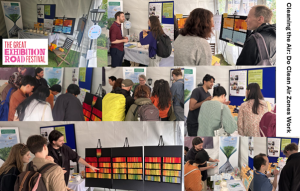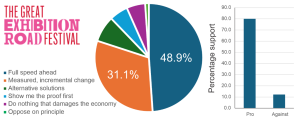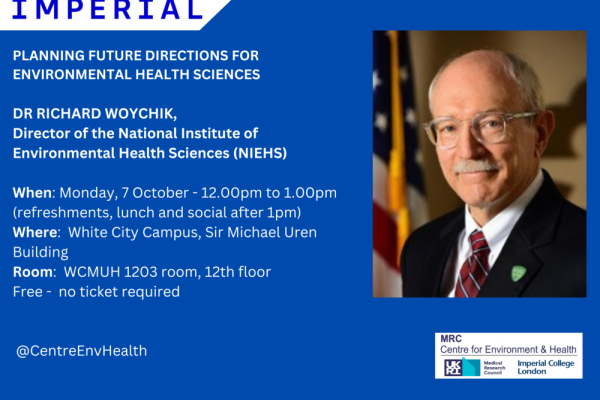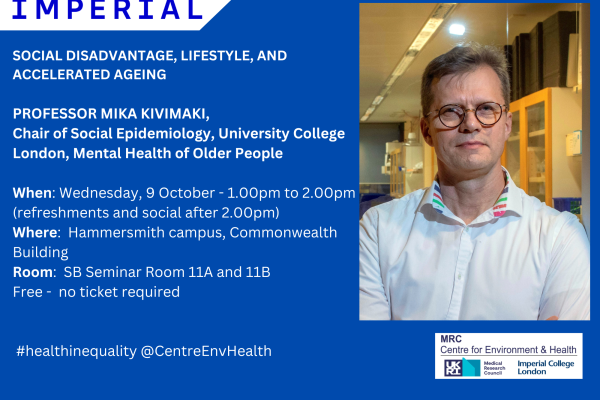Summary
The MRC Centre for Environment and Health actively participated in the Imperial Great Exhibition Road Festival on the weekend of June 7th and 8th, 2025. Our presence was primarily within the "Adult Only Zone – Cleaning the Air: Do Clean Air Zones Work," where our core objective was to engage the public and gather their perspectives on the implementation of Clean Air Zones (CAZs), such as London's Ultra Low Emission Zone (ULEZ), as a vital public health mechanism. The event successfully fostered a dynamic dialogue around air quality, policy impacts, and effective public communication strategies.
The MRC Centre for Environment and Health actively participated in the Imperial Great Exhibition Road Festival on the weekend of June 7th and 8th, 2025. Our presence was primarily within the “Adult Only Zone – Cleaning the Air: Do Clean Air Zones Work,” where our core objective was to engage the public and gather their perspectives on the implementation of Clean Air Zones (CAZs), such as London’s Ultra Low Emission Zone (ULEZ), as a vital public health mechanism. The event successfully fostered a dynamic dialogue around air quality, policy impacts, and effective public communication strategies.

Illustrating Policy Impact: Digital Resources and Crocheted Art
A key focus of our exhibit was to tangibly demonstrate the impact of CAZs. We leveraged digital resources, providing direct links via iPads to platforms like LAQN, Breathe London, and AWAIR. These resources allowed visitors to explore real-time and historical air quality data, illustrating how air pollution levels have changed since the introduction of the ULEZ. This digital engagement was complemented by a unique and compelling visual aid: the “Crochet the Air” exhibit. This innovative series of crocheted artworks visually depicted time series of Nitrogen Dioxide (NO2) concentrations across various sites in London, clearly showing the reduction in pollution levels over the ULEZ implementation period. This artistic approach, a collaboration with Queen Mary University of London (QMUL), served as a powerful conversation starter, linking policy to palpable environmental improvements. Individuals from the Children’s Health in London and Luton (CHILL) study, including Dr Helen Wood, Dr Rosamund Dove, and Jessica Mitchell, were on hand throughout both days to discuss the latest data and insights emerging from their research, directly linking the exhibit to ongoing scientific investigation.
Public Communication and Awareness: The AWAIR Project
Beyond policy impact, the festival provided a crucial platform to discuss the broader aspects of public communication regarding air pollution risks and levels. A significant highlight was the showcasing of the AWAIR project by Dr. Kayla Schulte, Stephanie Okeyo and community ambassador Jamila Bolton-Gordon. AWAIR is a pioneering initiative focused on the co-design, creation, and investigation of outdoor air quality displays. These displays aim to enhance community awareness and understanding of air quality forecasts and associated health risks through collaborative development with local communities. This aspect of our exhibit underscored the importance of accessible and community-tailored information in empowering individuals to understand and act upon air quality data.
Science Communication in the Spotlight: The Science Cabaret
A notable contribution to the festival’s intellectual and entertaining program was Dr. Ian Mudway’s participation in the Science Cabaret. His segment, “Clean Air Zones: Cutting Through the Sound and Fury to See the Health Gains,” delivered in collaboration with the award-winning improv comedy group “Do Not Adjust Your Stage,” effectively communicated complex scientific concepts in an engaging and accessible manner. This creative approach to science communication helped demystify the topic of CAZs, allowing for a broader audience to grasp the health benefits without getting bogged down in technical jargon.
Understanding Public Opinion on Clean Air Zones
A central component of our public engagement strategy was a comprehensive survey designed to gauge public sentiment on Clean Air Zones. We employed an innovative method using “piggy banks” to collect opinions across five distinct scenarios, each representing a nuanced public view on CAZ implementation. This interactive approach encouraged direct participation and provided clear visual representation of collective opinions.
The five scenarios presented were:
The “Full Speed Ahead” Fund: Question: “Imagine a city where air pollution is significantly reduced, leading to healthier residents and a greener environment. To achieve this, would you support the rapid introduction of a comprehensive Clean Air Zone across most of the city, even if it means some immediate costs or changes to travel habits for many people?”
The “Measured Progress” Pot: Question: “Do you believe that Clean Air Zones are a necessary tool for improving public health, but should only be introduced gradually, starting in the most polluted areas, and with significant financial support and alternative transport options provided for those affected?”
The “Alternative Solutions” Jar: Question: “While clean air is important, do you believe that Clean Air Zones are an overly restrictive and unfair way to tackle air pollution? Would you prefer to see investment focused primarily on other solutions like improving public transport, promoting cycling, and investing in greener technologies, rather than charging vehicles?”
The “Economic Protection” Chest: Question: “Given the potential impact on local businesses, commuters, and lower-income households, do you believe that Clean Air Zones are harmful to the economy and daily lives, and should therefore not be introduced at all?”
The “Show Me the Proof” Box: Question: “Do you believe that Clean Air Zones might be effective, but that their introduction should only proceed once there is clear, undeniable evidence from other cities demonstrating their significant positive impact on air quality without undue negative economic or social consequences?”
These scenarios provided a robust framework for discussing the evidence of CAZ effectiveness and encouraged participants to consider various facets of the policy.
Additional Public Feedback and Quantitative Results
To capture more detailed and contextual information, a “post-it note” board was set up, allowing attendees to record their views in more detail. This qualitative feedback provided rich insights into public concerns and aspirations. Common themes emerging from the post-it notes included:
Strong support for cleaner air and the undeniable health benefits (“The benefits are undeniable!”).
Calls for more radical action and continued efforts (“Carry on the good work, and be more radical”).
Emphasis on alternative transport solutions, such as better cycling lanes and improved public transport, along with reduced costs for public transport and electric vehicles.
Concerns about economic impacts on lower-income households, but also recognition of the long-term economic benefits of a healthier population.
Specific suggestions regarding air quality in the tube and main roads, and a desire for data-driven approaches.
The quantitative results from the “piggy bank” survey revealed a strong overall inclination towards the introduction of Clean Air Zones:

- Full Speed Ahead: 48.9%
- Measured, incremental change: 31.1%
- Alternative solutions: 7.8%
- Show me the proof first: 5.6%
- Do nothing that will damage the economy: 6.6%
- Oppose on principle, just another tax grab: 1.1%




